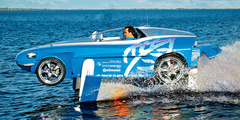The car sinks in about 30 seconds. This time is given to the driver and passengers to fully understand the error of the chosen path. Alas, such cases when the car is not in the water by the will of its owner is not uncommon. And if, on the contrary, by will? The temptation to drive off the asphalt in the water is great. It's no coincidence that one of Top Gear's highest-rated TV shows dedicated to turning ordinary cars into waterfowl.
It was time to switch from Clarkson's gasoline spice to Konetzky's salty romance. Farwater instead of double solid, knots instead of kilometers per hour, ship lights instead of headlights ... Slightly redesigned the decommissioned army amphibian Ford GPA, the Schneider family in the early 1950s, it passed more than 16,000 miles along the coast of both Americas, from Alaska to Tierra del Fuego. Not every owner of a yacht would dare to undertake such a journey.
While the vast majority of amphibians have learned to swim across rather than along. Their purpose is to cross the water barrier, if it arises in the way. It's a purely military task.
In fact, most amphibious cars were created for military purposes. Although, of course, there are exceptions. The first amphibian car is considered to be the design of François Rawaiier. On June 8, 1907, near Paris, the inventor slowly drove down a sandbank in the Seine and described a circle on the water. Amphibious Rawaiier, equipped with a gasoline engine of 20 hp, was, in fact, a boat loaded on wheels.
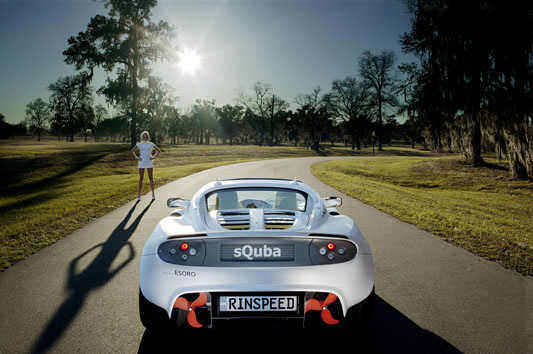
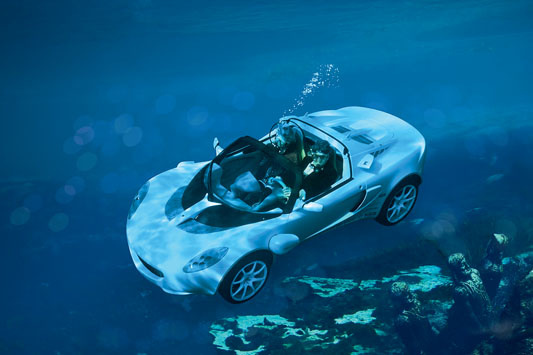
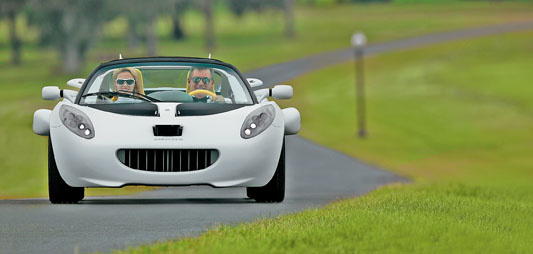
However, the Old Testament "walk on water, aki on dry" did not give inquisitive minds rest before. History keeps references to amphibians built long before the official appearance of the car ... The manuscript of 1436 brought to us the image of a ship moving on land on wheels. In 1588, the Italian inventor Agostino Ramelli built for the French king Henri the Third a crew that could dive into the water and swim with the muscle power of the rowers. The mechanic Charles Dallerme of Amiens created a steam engine in 1790 and patented its floating version. Around the same time, the American Oliver Evans was conducting his experiments with the «elastic force of steam» - steam was then relied on as today's nanotechnology. Evans contracts the Philadelphia Health Commission to build the Oructor Amphibolos, a self-propelled steam dredger. A public demonstration of the machine took place July 13, 1805, in front of the Philadelphia City Hall.
Those who had to participate in the launch of a boat or yacht know how laborious the process is. It requires a prepared stretch of shore, a crane and all kinds of tali to be successful. And the more feet from nose to stern, the harder it is.
Amphibians, on the other hand, are supposed to change the area to the water area and back without using auxiliary devices. Otherwise, the whole idea loses its meaning. However, at the very edge of water surface the car disassembles water fears: tires are knotted in shaky soil, the engine is choked and gets a water hammer, and through gaskets, which seemed quite reliable a minute before, fountains start to beat, not encouraging passengers. Returning to land is a whole problem. The front wheels, already touched the bottom, have about the same resistance as the anchor. At the same time, the rear, driving wheels have not yet found support and helplessly rattle in the water. Well, if the shore is sandy or pebbly - and if it's silt or stones?
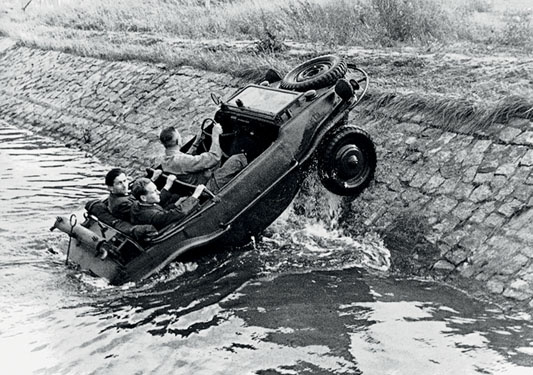
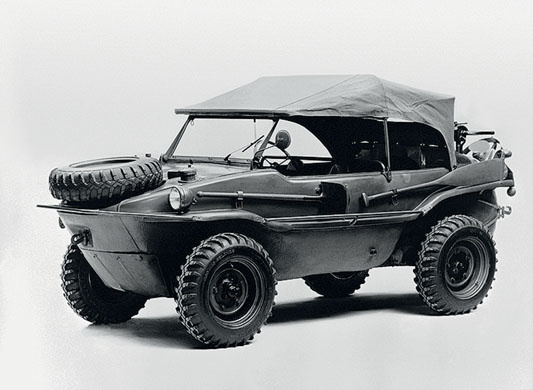
Being a sailor does not mean being a cross-country vehicle. The uniqueness of amphibians lies primarily in the combination of technical features. It is a fascinating glide of engineering thought in the boundary state between the boats and the car. Obviously, the design solutions of even the most luxurious serial vehicles are unlikely to suit amphibians. Rigid aluminium profile frames can also be found in supercars, but where else, asks, will you meet the bottom of a thick sheet that can withstand the blows of waves?
Amphibians were the first to have such tricky devices as tire pressure control and airtight door seals, which are inflated with air like bicycle tyres. It is especially difficult to achieve tightness of moving parts - hinges, shafts, steering rods. It is not without reason that the Amphicar operating instructions advised to carry out lubrication after each «water procedure».
Amphicar was the brainchild of the most famous amphibian designer - German Hans Trippel. The talented engineer did his time in a French prison for creating amphibians for the SS troops, after which he organized a small production of now completely peaceful water vehicles in West Berlin. The case was patronized by Kvandt himself, the head of a powerful financial empire.
The Amphicar amphibian became famous when prominent German biologist Bernard Grzimek made several races among hippos in Queen Elizabeth National Park, Uganda.
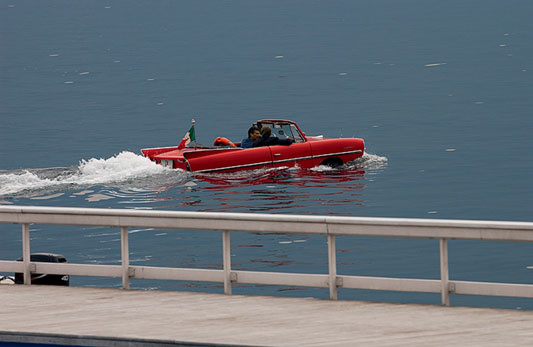
This is how the biologist himself writes about it in his book "Grzimek among African beasts": "On Amphicar, I crashed into the middle of a herd of hippos. Twice the males tried to lift my car on my back, waiting for it to tip over like any other boat. But the car stood the test.
By the way, Grzimek did not ignore the peculiarities of the unusual machine: "...the screws are mounted high between the rear wheels and therefore do not reach the bottom; even if you get stuck, it is not difficult to release, you just have to put the rear wheels in motion. However, it does take some time to change the engine and run aground, and if there's an angry Kafra buffalo standing on the shore at this point and making threatening drops in your direction, you start to feel a little uncomfortable.

Following Grzimek, Amphicar was acquired by John Lennon. Despite the fact that only 3,878 «amphibians were built between 1961 and 1968 out of a planned 25,000», this amphibian is now as popular as the Volkswagen Beetle. Even Madonna shot Amphicar in her video.
By the way, Grzimek touched upon a rather vulnerable point in his book: many of the amphibians can only turn on a water propeller after launching. As long as the amphibian is immobilized, the current can turn the car around and draw it after itself. Then the question is, where do we go? Screw, water cannon, wheel rotation, outboard engine? There were about as many options as classic small vessels. Oars, in case of emergency.
By the way, the rules of the Russian River Register oblige to have oars on board, as well as individual watercraft, the role of which in many amphibians perform ... seat cushions.
The best choice was the screw. With it, the ship-machine has the best running ability. However, the screw is easy to damage when going into the water and out on shore. The screw requires drive from the standard transmission, and the driver's life is complicated by additional levers. To increase maneuverability, the screw propeller must be supplemented with a steering unit like the ship's, which leads to complication of the OEM car steering mechanism. That is why on many amphibians during the evolution bypass the rotation of the steering wheels, and the movement is carried out on a dry, due to the rotation of the wheels. However, it is necessary to cross water artery with speed of a pedestrian - 4-5 km/h. You can't wait for more enthusiasm from such amphibian.
When in the mid-1980's in our country suddenly intensively engaged in the development of military amphibians, on the base of all-terrain vehicle UAZ-469 created a car with screws, and on the basis of "Niva" - able to move afloat due to the rotation of wheels. In both cases, the developers set a goal to ensure that the machines do not give away their amphibious essence. Shh! A war mystery! Interestingly, even in other countries at this time, amphibian cars were trying to get rid of the boat look.
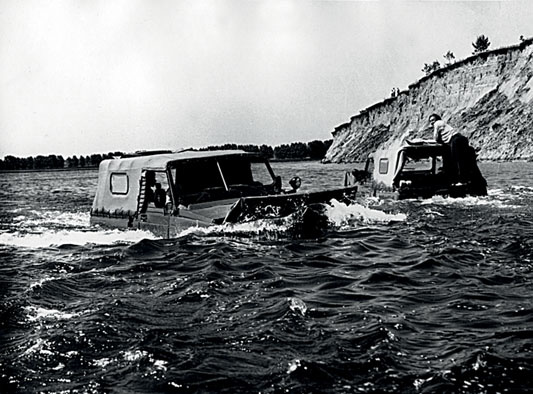
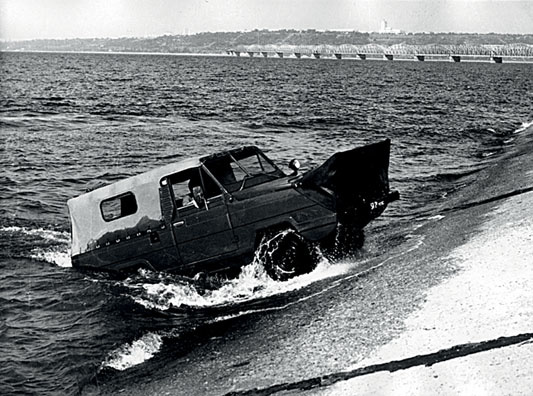
The mature amphibians were freed from such «adolescent» torments. They no longer want to resemble ships or cars. A typical example is the amphibian company Gibbs Technologies, founded in 1996 by New Zealand tycoon Alan Gibbs. He involved former designers of the British Jaguar car factory - Neil Jenkins, Jim Randle, Mike Gil. It was possible to untie the Gordian knot of amphibians - significantly reduce the resistance provided by the floating wheels and wheel niches. The wheels were pressed under the bottom of the hull - the amphibian went faster.
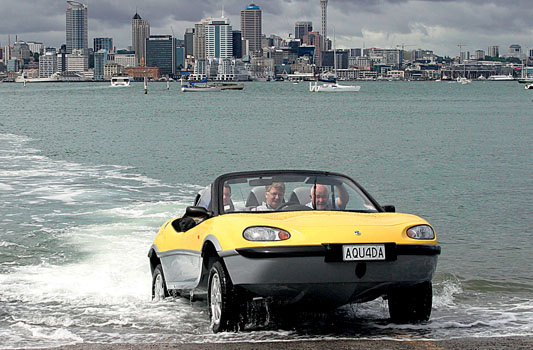
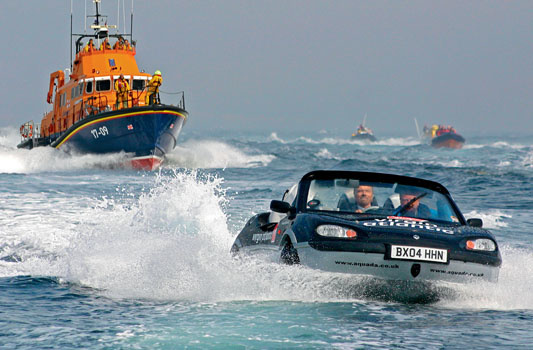
The famous British entrepreneur Sir Richard Branson, whose Virgin logo is painted on CDs, racing cars, airliners and even suborbital spacecraft, in 2004 chose the amphibian Gibbs Aquada to cross the Channel in a record 1 hour 40 minutes and 6 seconds. Equipped with a 175-horsepower diesel engine and a powerful water cannon, the Aquada travels on water at speeds previously unimaginable - 18-20 knots (36-40 km/h). And if it is even faster? The only way to reduce friction against water is to lift the amphibian body above water. And that's right - there's nothing the car can do in water. And it is pushed out of there by edan (in the case of Gibbs amphibian) and hydrofoils, like the Swiss inventor Frank Rinderknecht's Rinspeed Splash amphibian. 45 knots, 80 km/h!
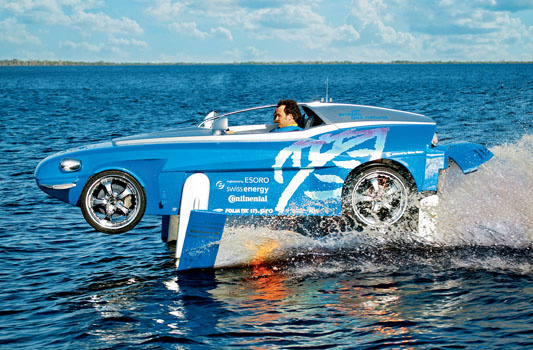
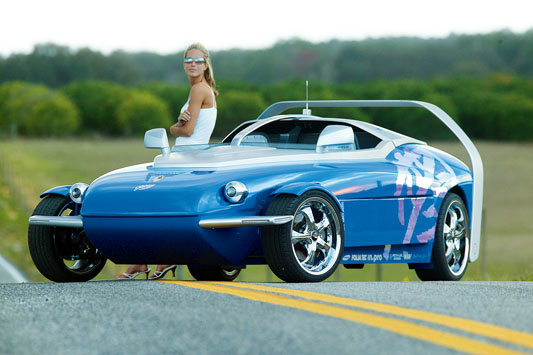
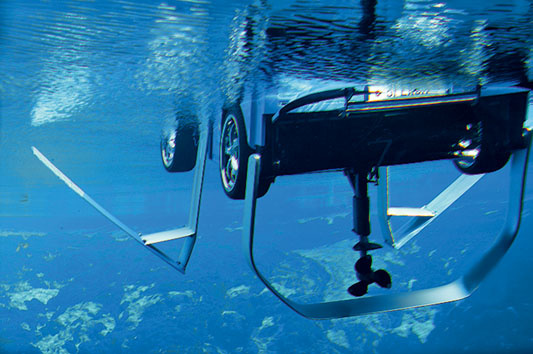

However, the Swiss, who is known in the automotive world as a great eccentric, built a submarine car sQuba, taking the sports Lotus Elise as a basis. That's what he ironized about the problems of automakers...
What other designs are ahead of us? You can only guess about that. Perhaps the car will be taught to fly. For the Scripture says, "Thoughts in the heart of man are deep waters.
The text is Denis Orlov. Photos - car companies
Published in YACHTS magazine #35.

